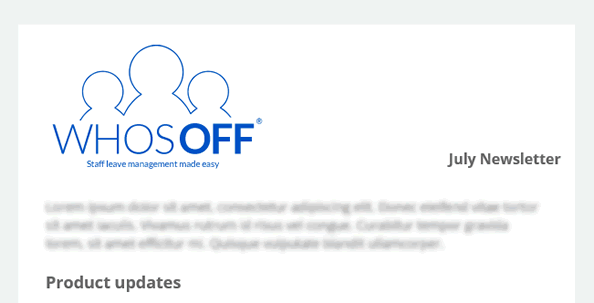We’re coming to the time of year when employees ask whether they can carry over annual leave.
Sometimes carryover is a great idea: it takes the pressure off ‘using up’ holiday during a busy trading period. However, carrying over annual leave can also create problems – for example, staff keep adding to their annual leave entitlement until it’s practically impossible to use up.
We’ve already written a blog post on whether carryover is a good or bad idea for employers. Here, we want to help businesses that have chosen to offer carryover implement plans successfully, using these six strategies:
1. Put a limit on carryover
Embracing carryover doesn’t mean letting staff save as much leave as they want for next year. This could create more problems than it solves. If you’re struggling to coordinate staff holiday now, imagine how much harder it will be when some team members have double their current entitlement to use.
Many companies offer carryover as a way to help staff work more flexibly. Some years people have lots of reasons to take time off; other years life is quieter, or they’ve been busy with an intense work project.
Giving teams the option to roll a handful of days over to next year stops them having to use that time arbitrarily. The exact limit will depend on your total leave allowance, but many companies allow staff to carry over 3-5 days of unused holiday each year.
2. Set clear deadlines for using rolled over leave
Here’s where company leave policies start to diversify. Some firms are happy to have an open ended carryover system. Others set firm deadlines – for example, any leave rolled over must be used within the first three months of the following year.
There are pros and cons to both approaches. Open ended carryover policies give your staff greater flexibility, but they could allow your team to amass a huge volume of rolled over holiday year on year. Strict deadlines get carryover used up quicker, but they put pressure on people to take time off when they have no significant plans.
It’s a personal decision whether your company limits the amount of time for staff to use carry over. Just make sure you look at what’s happening within the company during the first 3-6 months of the year if you’re considering time restrictions.
3. Document carryover guidelines in your annual leave policy
The most important factor in any annual leave policy is clear documentation. Your workforce needs to know the rules and feel confident that policies are applied consistently across the company.
Often carryover starts as an informal arrangement; an employee who hasn’t managed to use their annual leave entitlement goes to their manager or HR to ask if they can save a few days for next year. On an individual level this is fine, but what about their colleagues who might have also wanted to save time off – but didn’t know it was possible?
Formalising carryover guidelines within your annual leave policy will take the ‘grey areas’ out of managing employee leave. Staff know exactly where they stand, which makes holiday admin easier to manage.
4. Communicate your carryover policy to staff EVERY YEAR
Once you’ve created a carryover policy and added it to your staff leave guidelines, make sure this information is shared with your entire workforce.
More importantly, share your holiday rollover policy year on year. People may have joined the company in the last 12 months; others may have forgotten what carryover is allowed. Sharing information refreshes people’s memories and helps staff to make decisions on whether they want to carry over leave.
5. Keep a close eye on how much leave staff are using
With your carryover system up and running and the new holiday year under way, it would be easy to put leave management on the backburner until next year. However, paying close attention to how much holiday employees are using can prevent carryover problems further down the line.
For example: employees who’ve carried over holiday will have more days off to use. As an employer, you want to avoid them saving all this time until the end of the year and then wanting to take a huge chunk of time off.
Many companies invest in online holiday management systems to help them track staff leave throughout the year. A central platform allows you to calculate carryover for each team member and see at-a-glance how many days off they still need to use.
6. Review your carryover policy in 12 months’ time
Business leaders are constantly learning – so it makes sense to check your carryover policy annually. Regular reviews will give you a chance to iron out problems and make improvements, so you can continuously enhance your company culture.
It also provides an opportunity to reassess whether the tools you’re using to manage staff leave are fit for the job. You might be happy planning employee holiday in a spreadsheet now, but if you’re introducing carryover, calculations could become more complex over the next 12 months. In that case, it could be time to invest in an online leave management system like WhosOff.
WhosOff is an easy-to-use work leave planner that helps you to keep track of staff movements while spending less time and energy on admin. Our platform will help you to accurately monitor staff holiday entitlement and set rules and restrictions to make sure policies like carryover are enforced correctly.
Start your free WhosOff trial today to simplify carrying over staff leave.
Similar articles
10.APR.2025
As a business owner, HR manager, or professional responsible for managing a team, one of the key tasks you will face is understanding and planning for the number of working days in a year and working weeks in a year. Using an online leave management tool such as WhosOff can relieve some of this burden.
01.APR.2025
As the new financial year begins, businesses are gearing up to streamline operations, optimize resources, and ensure smooth workflows. One critical aspect of this preparation is managing staff leave effectively, here's where WhosOff can help.
28.JAN.2025
As a fundamental part of any business running smoothly, the management and tracking of staff leave is often a task that can be overlooked but can have a major impact on operations when things go wrong.
16.OCT.2024
Learn how our customers have accelerated their internal business processes by integrating with the WhosOff API to manage their staff leave and absence tasks.


